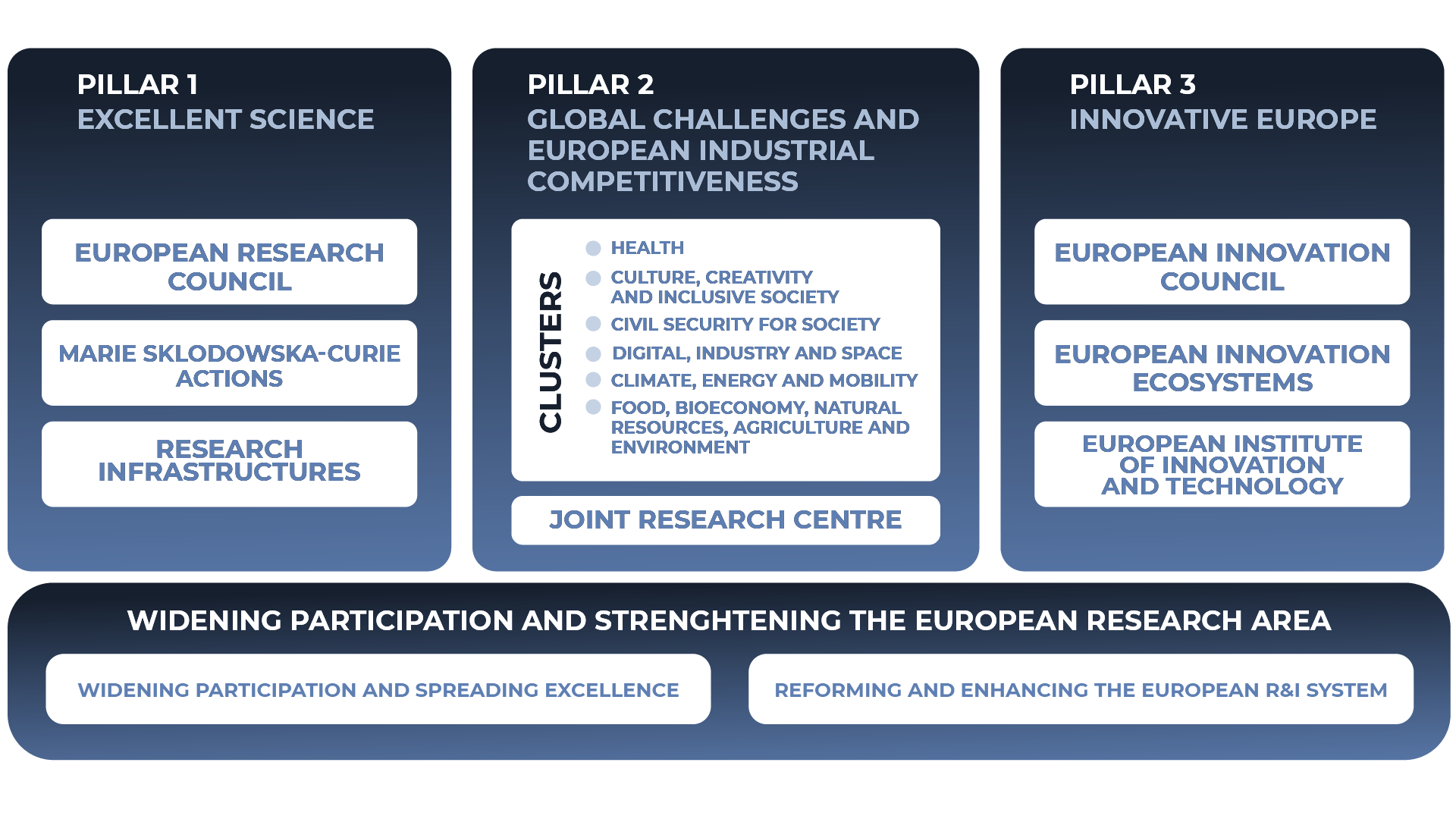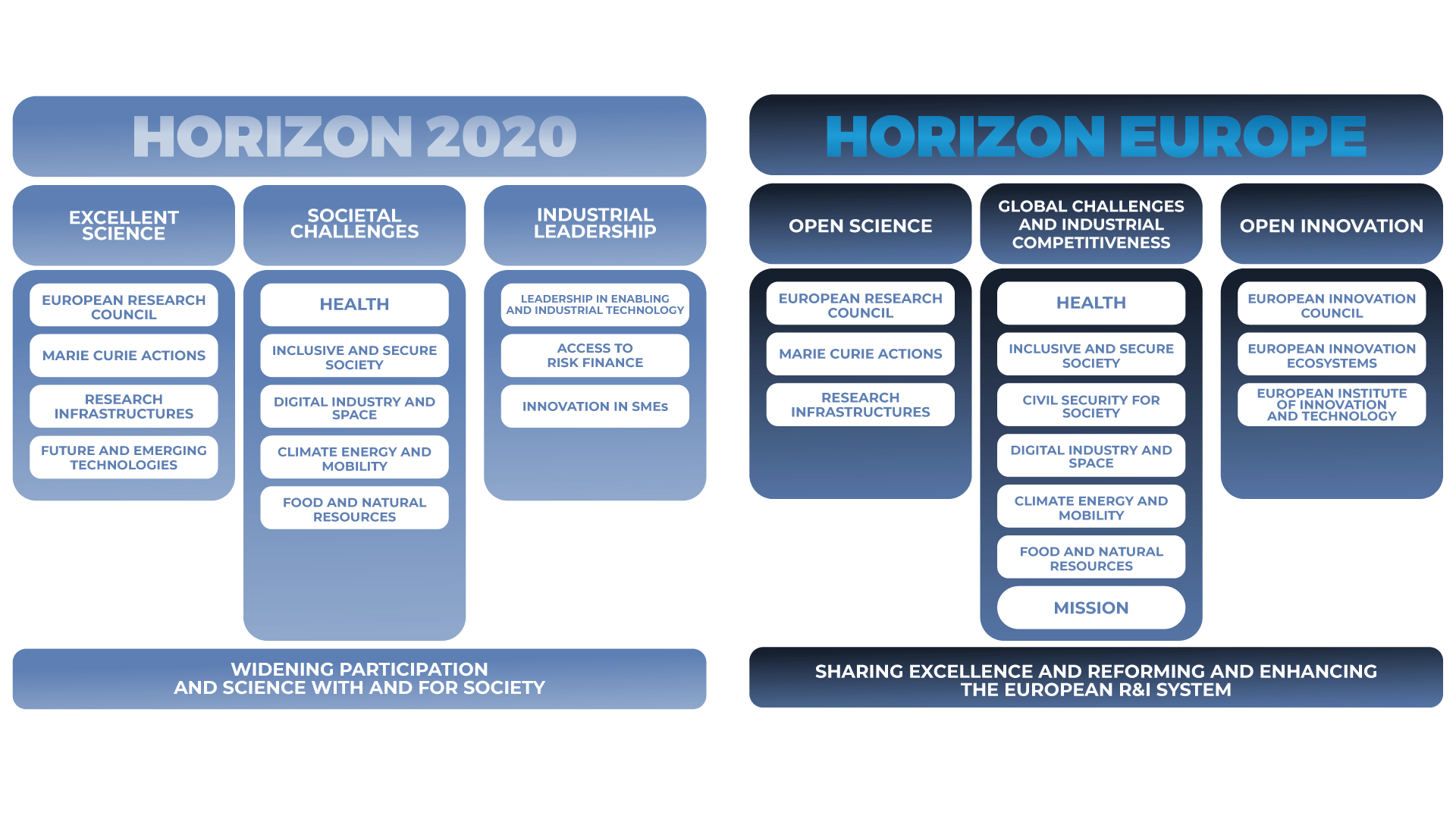
WHAT IS HORIZON EUROPE?
EU’s next MFF budget and Next Generation Europe
Key Facts & Figures
More than 50% of the budget supports modernisation through policies that include:
- Research and Innovation, via Horizon Europe.
- Fair climate and digital transitions, via the Just Transition Fund and the Digital Europe programme.
- Preparedness, recovery and resilience, via the Recovery and Resilience Facility and a new Health Programme, EU4Health.
Traditional policies such as the cohesion and common agricultural policy will be modernised and receive a significant EU budget to support the green and digital transitions.
30% of EU funding, under both NextGenerationEU and MFF, will be dedicated to fight climate change. The package also gives specific attention to biodiversity protection and gender mainstreaming.
RECOVERY INSTRUMENT
DEPLOYMENT & ADOPTION
INFRASTRUCTURE
When you put NextGenerationEU on top, we now have a massive and unprecedented financial firepower. EUR 1.8 trillion. That is almost 13% of our EU27 GNI. And MFF and NextGenerationEU together will increase the percentage of modern policies to over 50%. Just look around the world to see who else can say the same as us. We now have the opportunity to achieve something historic for Europe together. The pressure of the crisis has opened doors that for a very long time were locked shut. As sad as the occasion may be, it is also a new opportunity for Europe, for our community.Ursula von der Leyen
President of the European Commission
Zooming into Horizon Europe
Investments in research and innovation ensure
a sustainable and inclusive future
Investments in research and innovation ensure a sustainable and inclusive future
What are its main objectives?
Europe must invest in research and innovation
to maintain its scientific and technological leadership
Europe must invest in research and innovation to maintain its scientific and technological leadership
What’s its structure?

PILLAR 1
The Excellent Science Pillar aims to increase the EU’s global scientific competitiveness. It supports frontier research projects driven by top researchers through the European Research Council, funds fellowships for experienced researchers, doctoral training networks and exchanges through Marie Skłodowska-Curie Actions, and invests in world-class research infrastructures.
PILLAR 2
The Global Challenges and European Industrial Competitiveness Pillar supports research relating to societal challenges and reinforces technological and industrial capacities through clusters. It sets ambitious goals for EU missions. It also includes the Joint Research Centre which supports EU and national policymakers with independent scientific evidence and technical support.
PILLAR 3
The Innovative Europe Pillar aims to make Europe a frontrunner in market-creating innovation via the European Innovation Council. It also helps to develop the overall EU innovation landscape through the European Institute of Innovation and Technology which fosters integration of the knowledge triangle of education, research and innovation.
HORIZONTAL PILLAR
Widening Participation and Strengthening the European Research Area (ERA) by increasing support to the EU Member States in their efforts to make the most of their national research and innovation potential, fostering closer collaborations and spreading excellence.
Novelties to advance progress
Budget and Timeline
Enhanced Impact
What’s new in comparison to H2020?

Changes to Pillar 1: Excellent Science vs Open Science.
‘Future and Emerging Technologies’ (FET) has been removed from this pillar and spread out across the other two. FET Flagship actions have evolved into the Mission actions in Pillar 2, whilst the remaining FET actions moved to Pillar 3, with a focus on market-making breakthrough/disruptive innovation.
Changes to Pillar 2: Societal vs Global Challenges and Industrial Competitiveness.
The main difference here is the addition of so-called Missions that are similar to H2020 FET flagship projects, but with set challenges aiming to boldly impact society and policy-making for a significant part of Europe.
Changes to Pillar 3: Industrial Leadership vs Open Innovation.
Where the focus is on stimulating and supporting market-creating breakthrough innovations. The three main components are:
- The European Innovation Council (EIC) which supports breakthrough innovations, with either ‘Pathfinder’ grants (for early tech) or ‘Accelerator’ funding (for pre-commercial work).
- The European Innovation Ecosystems (EIE) which focuses on developing networks of interactions between innovators.
- The European Institute of Innovation and Technology (EIT) which brings key research, education, and business actors together around a common goal.
Changes to the horizontal pillar: several planned actions.
Which support these three Pillars, to widen participation and reform/enhance the current systems, include:
- More participation from non-EU countries with good capacity in science, technology, and innovation.
- An update to partnership approaches, consolidating them into three possible forms: Co-programmed, Co-funded and Institutionalised.
- It’s mandatory that publications and data produced through the programme are open access.

European Innovation Council
The EIC aims to identify and support breakthrough technologies and game changing innovations to create new markets and scale up internationally.
The EIC is a key novelty of Horizon Europe and represents the most ambitious innovation initiative that Europe has taken, with a budget of €10 billion for the period 2021-2027 and funding opportunities worth more than €1.5 billion in 2021 only!
EIC Pathfinder
Support to research teams to research or develop an emerging breakthrough technology
EIC Transition
Mature a novel technology and develop a business case to bring it to market
EIC Accelerator
Funding and investments through the EIC Fund for individual start-ups and small companies to develop and scale-up game-changing innovations
EIC Business Acceleration Services
All EIC supported projects and companies get access to coaching, mentoring, partnering and other EIC Business Acceleration Services
European Innovation Ecosystems
Specific support to enable innovation ecosystem actors to work together across Europe
EIC Prizes
Take the challenge and compete for an EIC Prize which rewards Europe’s leading innovators
Horizon Europe – Mission Areas
Missions are:
- be bold, inspirational and widely relevant to society
- be clearly framed: targeted, measurable and time-bound
- establish impact-driven but realistic goals
- mobilise resources
- link activities across different disciplines and types of research and innovation
- drive a systemic change and transform landscapes rather than fix problems in existing ones
The areas covered by the mission are:
- Cancer
- Adaptation to climate change including societal transformation
- Healthy oceans, seas, coastal and inland waters
- Climate-neutral and smart cities
- Soil health and food
Partnerships in Horizon Europe
How do I apply?
Stay tuned on our channels to find out more or drop us an email!
OUR TIPS & TRICKS
– STAY FOCUSSED –
Target the right call with the right partners.
Based on more than 25 years of experience in EC funding with an average 30% success rate in Horizon 2020 and Horizon Europe, our expert team can support you in your Horizon Europe journey.
MAIN HIGHLIGHTS
Next Generation
Europe
NextGenerationEU is a €750 billion temporary recovery instrument to raise funds on the capital market. It helps repair the immediate economic and social damage brought about by the Coronavirus pandemic. The ambition is to ensure that post-COVID-19 Europe will be greener, more digital, more resilient and fit for current and forthcoming challenges.
Digital
Europe Programme
As part of the MFF 2021-2027, this programme is focused on building the strategic digital capacities of the EU and on facilitating the wide deployment of digital technologies across the economy and society. With a planned overall budget of €8.2 billion, it boosts investments in supercomputing, artificial intelligence, cybersecurity, and advanced digital skills.
Connecting European Facilities 2
As part of the MFF 2021-2027, the EC proposed a total budget of €31.7 billion to support infrastructure projects connecting regions within the EU (the trans-European networks). CEF 2 seeks to better integrate transport, energy and digital sectors, and help achieve EU climate objectives, while supporting jobs, economic growth and the deployment of new technologies.
Next Generation Europe
NextGenerationEU is a €750 billion temporary recovery instrument to raise funds on the capital market. It will help repair the immediate economic and social damage brought about by the Coronavirus pandemic. The ambition is to ensure that post-COVID-19 Europe will be greener, more digital, more resilient and fit for current and forthcoming challenges.
Digital Europe Programme
As part of the MFF 2021-2027, this programme is focused on building the strategic digital capacities of the EU and on facilitating the wide deployment of digital technologies across the economy and society. With a planned overall budget of €8.2 billion, it will boost investments in supercomputing, artificial intelligence, cybersecurity, and advanced digital skills.
Connecting European Facilities 2
As part of the MFF 2021-2027, the EC proposed a total budget of €31.7 billion to support infrastructure projects connecting regions within the EU (the trans-European networks). CEF 2 seeks to better integrate transport, energy and digital sectors, and help achieve EU climate objectives, while supporting jobs, economic growth and the deployment of new technologies.
Investments in research and innovation improve Europeans’ quality of life. Research and innovation accelerate the green and digital transformations that our planet needs, but also increase the competitiveness of our economies. The EU and Member States need to allocate enough resources in science, research and innovation to shape the future we want.Mariya Gabriel
EU Commissioner for Innovation, Research, Culture, Education and Youth
